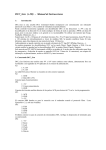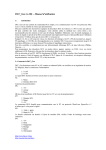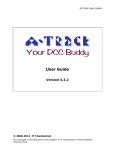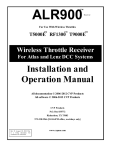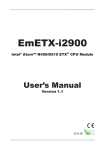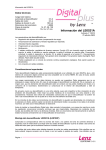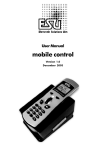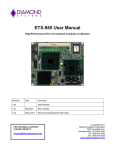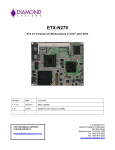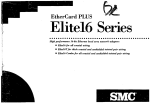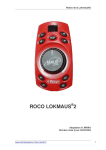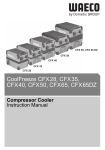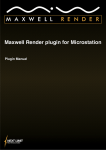Download DCC_Gen (v.2D) – User Manual
Transcript
DCC_Gen (v.2D) – User Manual 1.- Introduction DCC_Gen is a simple DCC Command Station with PC communication (Lenz Xbus v.3.0 protocol) and speed control by potentiometer. It can control locomotives equipped with DCC decoder in addresses 1 to 99. There is an address 00 analog loco available. This allows control of a conventional (non DCC) loco by the 'stretched zeros' method, not advised for ironless rotor motors (Escap, Faulhaber, Minimotor etc). In analog mode, the waveform is similar to a conventional PWM but is a bit noisy and is not recommended for a long time use. Use only DCC locos if you can Supports 14, 28 y 128 speed steps, functions FL and F1 to F8 for locomotives, up to 99 turnouts and 128 feedback inputs with S88 modules. You can establish up to 26 different routes, for it there are up to 254 turnout memories. Additionally it can be controlled by RC5 type TV remote (Philips, Daewoo ...) It can program DCC decoders in Direct, Paged, Register and PoM modes. With an auxiliary circuit it can read DCC decoders in Direct, Paged and Register modes. It only need a PIC 16F876 working at 8MHz, a 16 keys keyboard and two pushbuttons for Emergency Stop and Menu Select function in a LCD display (2 lines of 16 characters), and IR receiver, a potentiometer, one MAX232 driver and inverters. 2.- Connecting DCC_Gen DCC_Gen works between 9V and 16V in DC or AC, (it internally has a rectifier and one 5V voltage regulator) in power connector. X3: 1: 9..16V 2: 9..16V DCC signal for booster is in another connector. X2: 1: GND 2: DCC Data (5V) Potentiometer connector: JP6: 1: +5V 2: cursor 3: GND Auxiliary circuit ACK detector input (for reading CV) over programming track: JP7: 1: ACK 2: GND 3: +5V DB9 female connector for PC communication using Xbus / Lenz XpressNet v.3 protocol, and only uses 4 signals: JP5: 2: TXD 3: RXD 5: GND 8: CTS The last connector is for S88 feedback modules, verify pin order before connecting. JP4: 1: +5V 2: Reset 3: Load 4: Clock 5: GND 6: Data in http://www.fut.es/~fmco http://usuaris.tinet.org/fmco When powered, DCC_Gen shows the welcome screen: DCC-Gen Command Station Then it shows the version number: Ver: 2D 12/03/05 By F.M.CAÑADA After this it will show the Loco Selection menu. 2.- Keyboard DCC_Gen uses a 16 keys keyboard and two additional pushbuttons, with this distribution: 7 4 1 < 8 5 2 0 9 6 3 > ENT UP DWN FNC STP SEL The STP key is the Emergency Stop, when pressed all locomotives will stop and the display shows ‘Emergency Stop!’ to continue operation press STP or the SEL key. The SEL key is used to change between menus. All keys have the auto repeat feature. The TV remote is like the keyboard, due to different keys distribution on TV remote keyboards some functions can be accessed using different keys: 7 8 9 OK TXT VOL+ I-II 4 5 6 YELLOW 1 2 3 V GREEN STDBY < RED 0 > BLUE MUTE VOL- MENU P+ ^ Colours are teletext keys. http://www.fut.es/~fmco http://usuaris.tinet.org/fmco 3.- Menus Using the SEL key you change the menu, when a menu has a ‘>’ symbol indicates a submenu to which you can access pressing the ‘ENT’ key. These are the different menus. Feedback: 65-66 1-3----8-2----7- Mikado 12:35 03: <000 14 *……… Routes 12:35 Play. A-001: 01/ Service Mode > Select Loco: 03 03: <000 14 *……… CV Direct Pag/Rg 0001-000 001-00 Parameters > Loco Name 03 14 Mikado Language: English DC Speed: Slow Hour Scale 12:35 24:1 Routes free: 254 Rec. A-001: 01/ 3.1.- Locomotive selection and control Select Loco: ---: STOP 128 *……… Initially there is no locomotive selected, enter locomotive number with numeric keys and press ‘ENT’. For example 03: Mikado 03: >000 14 12:45 -……… The screen shows the locomotive bane, the current time in the scaled time, second line indicates that you are controlling locomotive 03, now is stopped, uses 14 steps and it haven’t any function active. With ‘FNC’ key you turn on and off FL, usually locomotive’s light. For additional functions press ‘1’, to control the F1 function, ‘2’ controls F2 and so on up to ‘8’ for F8. With the potentiometer or the ‘<’ y ‘>’ keys you can change the current speed and direction of the locomotive. For example, pressing ‘>’ key twice and pressing ‘FNC’: Select Loco: 03 03:>>002 14 *……… Locomotive 03, moving forward, speed 2, 14 speed steps and light on. The first ‘>’ symbol indicates the direction towards you have to move potentiometer to match current speed for controlling the locomotive, when both match, the first ‘>’ disappear and when you move the potentiometer the speed changes accordingly. To control another locomotive, press ‘ENT’ key type its number and press ‘ENT’. Address 00 is for an analog locomotive (not equipped with digital decoder), functions aren’t functional. (speed control is done by ‘stretching zeroes’ method). http://www.fut.es/~fmco http://usuaris.tinet.org/fmco In locomotive selection menu with the ‘UP’ key you can change between 14, 28 or 128 speed steps to control the locomotive. Select according the programming of the locomotive decoder. You can set individually the default speed steps in the programming locomotive name menu. DCC_Gen ‘remembers’ the 16 last entered locos, if you re-enter the number you get the values it has at the moment of change. How many locomotives ‘remember‘ and specially if one is the analog loco, more slowly is the system answer, if one is not used we can do that DCC_Gen ‘forgets’ it pressing ‘DWN’ key when the loco is stopped. Press ENT: Select Loco: 03 03: >000 14 *……… Press ‘UP’ Select Loco: 03 03: >000 28 *……… Press DWN: Select Loco: 03 --: STOP 128 -……… Type 00 and press ENT: Analog 00: >000 14 12:45 -……… For a fast change between locomotives that DCC_Gen ‘remembers’ you only have to press ‘UP’ and to stop the current locomotive with his pre-programmed deceleration without pressing speed keys or rotating pot just push ‘DWN’. 3.2.- Route Control The control of turnouts, accessories and programmed routes (sequential and automatic turnout change) is done in this menu: Routes 12:35 Play A-001: 04/ The screen shows the playing mode, current route is ‘A’, and the first turnout in the route is number 4 set to diverging. You can also see the current time accordingly to selected time scale. With the ‘UP’ and ‘DWN’ keys we change the route from ‘A’ to ‘Z’ and pressing the ‘ENT’ key we play the programmed route, every short time a turnout of the route is moved until the end of the programmed route. To revise the programmed route use ‘<’ y ‘>’ keys, when 00 is showed indicates the end of the route. To manually move a turnout, type its number (01 to 99) with numeric keys and press ‘FNC’ to move between straight ‘|’ or diverging ‘/’ and vice versa. This not erases the programmed route. http://www.fut.es/~fmco http://usuaris.tinet.org/fmco 3.3.- Service Mode To enter Service mode to program decoders, record of routes and change DCC_Gen parameters press ‘ENT’ in this menu: Service Mode > When entering Service Mode, all locos will stop, when exiting Service Mode all locos have its speed set to zero. When programming CV, all loco in the layout will be programmed, so before programming left only one loco in the layout. In this menu, if you press FNC the screen will show the feedback status, you can continue controlling the loco but the UP y DWN keys now select the different S88 modules. Pressing SEL key you return to Service Mode selection menu. Feedback: 65-66 1-3----8-2----7- 3.3.1.- CV Programming With DCC_Gen you can program all the CV range (1 to 1024) in four different modes (Direct, Paged, Physical and PoM). The programming have to be done with only ONE locomotive on the track, if not all locomotives get the same programming data. With an auxiliary circuit you get an programming track output in which you can also read the CV in Direct, Paged y Physical modes (if you don’t connect the auxiliary circuit place an 10K resistor between pins 1 and 2 of JP7). CV reading is only possible in programming track, writing CV can be done on programming or main track. When you put a locomotive in the programming track and enter Service Mode (locomotive must be stopped and light and functions off) the auxiliary circuit LED must remain off, when programming a CV the LED must light on when the loco makes a ‘click’. If the potentiometer is correctly adjusted and occurs the things as described, when reading a CV depending on read mode (Direct, Paged) the LED lights some times during reading. Check when you read a know CV (CV1, CV7, CV8 for example) the data readed is correct. CV ----0001-000 Pag/Rg 001-00 Not all the decoders supports all programming modes, select the convenient with keys ‘1’ to ‘4’ (1:Direct, 2: Paged, 3:Physical, 4:PoM). For example, when you press ‘2’: CV Paged 0001-000 Pag/Rg 001-00 With ‘UP’ y ‘DWN’ keys select the CV to modify, on the right shows the corresponding page/register. For a fast access to decoder accessory CV (513 and above) is possible to decrement with ‘DWN’ after selecting CV1, then it shows CV512. With ‘<’ y ‘>’ keys select the value to program between 0 to 255 for the selected CV, read the manual of your decoder for the range an mode to use. http://www.fut.es/~fmco http://usuaris.tinet.org/fmco When you press ‘ENT’ begin the programming, he screen shows 'Programming CV', the LED in the auxiliary circuit lights for a moment and the loco ‘clicks’, is the acknowledge ACK pulse. If the pulse is not detected, the screen shows 'ACK Error'. Some decoders don’t use new programming values until you retire and then put the loco on track. To read a CV put the loco in the programming track and press 'FNC', the screen shows ‘Reading CV…’ in a few seconds depending on the programming mode it shows the read value. If ACK pulses aren’t detected the screen shows ‘ACK Error’. For example, to program acceleration (CV3) to a value of 10 in Direct mode: CV Direct Pag/Rg 0003-010 001-02 CV Direct Pag/Rg Programming CV.. CV Direct Pag/Rg 0003-010 001-02 When reading CV8 in Paged mode (it can last up to 15 seconds) of a Lenz decoder: CV Paged 0008-000 Pag/Rg 002-03 CV Paged Pag/Rg Reading CV… CV Paged 0008-099 Pag/Rg 002-03 In case of error when programming or reading, the screen shows: ACK Error Pag/Rg 0008-000 002-03 http://www.fut.es/~fmco http://usuaris.tinet.org/fmco 3.3.2.- Programming Routes Routes free: 254 Rec A-001: 00/ The screen shows the available memory for routes (254 turnouts), the record mode, the selected route (A), the number of sequence inside the route (001) and the turnout to move (00: not programmed) to straight ‘|’ or diverging’/’ position. DCC_Gen supports up to 26 routes and can control turnouts 1 to 99, this are record in memory even you power off the unit. An example of a route to program: Sequence 1 2 3 4 Turnout 02 05 04 11 Direction / / | / With ‘UP’and ‘DWN’ keys select the route (A to Z) to program. With numeric keypad enter the number of the first turnout (02), to change the direction of the turnout press ‘FNC’, this also sends the DCC order to the track so corresponding turnout is moved. Routes Free: 254 Rec A-001: 02/ When is positioned on the correct direction (diverging in this case) press ‘ENT’ key and will be saved in memory, automatically the number of sequence is incremented and decrements the routes free counter: Routes Free: 253 Rec A-002: 00/ Repeat the process for the next sequences: Routes Free: 253 Rec A-002: 05/ Routes Free: 252 Rec A-003: 04| Routes Free: 251 Rec A-004: 11/ Routes Free: 250 Rec A-005: 00/ In operations mode, select the Route Control menu, choose route A and press ‘ENT’, then the programmed sequence will be executed: turnout 02 diverging, a few time after turnout 05 diverging, then 04 straight and at the end 11 diverging. During route programming is possible to modify or delete a sequence, with ‘<’ y ‘>’ keys select the sequence to change and press the new turnout number, the direction and ‘ENT’. To delete a sequence enter 00 as number of turnout and press ‘ENT’, automatically route memory counter Hill be incremented. http://www.fut.es/~fmco http://usuaris.tinet.org/fmco 3.3.3.- DCC_Gen Parameters To modify DCC_Gen parameters: Language, Loco names, scaled clock and DC speed mode, press ‘ENT’ in this menu: Parameters > 3.3.3.1.- Locomotive Names and default speed steps You can change the name of the current locomotive selected or its default speed steps: Loco Name 03 128 Mikado The menu shows the currently locomotive select name (up to 9 letters) and the default speed steps. With the ‘<’ y ‘>’ keys you can move the cursor and with UP y DWN keys you can select other letter for the current cursor position, when you press ENT it will be saved into memory. By pressing FNC key you can select between 14, 28 y 128 speed steps. To save the new selections into memory just press ENT. Loco Name 03 128 Big Boy 3.3.3.2.- Language It’s possible to change the language of the menus between ‘Castellano’ and ‘English’. Language: English To change between languages press ‘<’ and ‘>’ or ‘UP’ and ‘DWN’, to select it permanently even after power off, when you select the language press ‘ENT’. Idioma: Castellano 3.3.3.3.- DC Speed It’s possible to change the mode that DC voltage is generated for loco 00 (not equipped with decoder) between ‘Slow’ and ‘Fast’ in first mode speed is increased slowly on first steps, on the second increments are faster (Not all engines works equally and is not recommended to run a locomotive without decoder) DC Speed: Slow To change between modes press ‘<’ and ‘>’ or ‘UP’ and DWN’ keys, to select it permanently even after power off, when you select the mode press ‘ENT’. DC Speed: Fast http://www.fut.es/~fmco http://usuaris.tinet.org/fmco 3.3.3.4.- Fast Clock You can select the fast clock scale between one of 16 values: 1:1, 2:1, 3:1, 4:1, 5:1, 6:1, 7:1, 8:1, 10:1, 12:1, 15:1, 20:1, 24:1, 30:1, 40:1 and 60:1. Hour 12:35 Scale 24:1 To change hours press ‘<’, to change minutes press ‘UP’ and to select a scale value press ‘FNC’, to select it permanently even after power off, when you select the scale press ‘ENT’. Hour 14:50 4.- Scale 60:1 Feedback For a full computer control of the layout, besides controlling locomotives and turnouts and signals, the computer need information of where are the locomotives (which track is occupied, etc,...). DCC_Gen supports compatible Märklin S88 feedback modules, these modules have 16 inputs each and you can chain up to 8 modules, so you can verify the status of 128 inputs. The nearest module connected to DCC_Gen have the lowest address, in this case 65 and 66 (in Lenz is the default address, it only uses 8 inputs per module and the S88 have 16 inputs). Verify the correct signal order when you connect the cable between DCC_Gen and the S88. Inside Service mode select menu if you press ENT it will show the feedback status screen, you also can control a locomotiva but now the UP and DWN keys shows the different inputs status of the S88 modules. When you press SEL you return to Service Mode select menu. Feedback: 65-66 1-3----8-2----7In this case, in the S88 module with address 65 and 66, (the nearest to DCC_Gen) are active inputs 1, 3,8,10 and 15 corresponding to 65.1, 65.3, 65.8, 66.2 y 66.7 in Lenz addressing. http://www.fut.es/~fmco http://usuaris.tinet.org/fmco 5.- Computer connection The connection between DCC_Gen and PC is done in the connector DB9F in 9600 bauds, 8 data bits, 1 stop bit, no parity and hardware flow control CTS. The flow control permits to stop data communication from PC, the RTS signal from computer isn’t observed. It only uses four connection cables, but all wires are connected in the correct form like a modem so you have to use a standard modem connection cable. DCC_Gen implements a wide variety of Lenz Xbus v.3, v.2 and v.1 commands, some characteristics to be observed are: - Locomotives address range only between 1 to 99 (with v.3 commands: AH=0) - Supported CV programming modes are Paged, Direct y Physical but only for CV 1 to 256, this is a v.3 limit. To program the full range (1 to 1024) use PoM mode if your decoder have support or manually in DCC_Gen menu that supports the full range for all modes. - Everything Off is not supported because DCC_Gen can disconnect the booster, it generates the Emergency Stop effect. - Requesting feedback out of the range of the S88 (65 to 80) returns accessory without feedback (this includes turnouts). - Emergency stop of all locomotives only affects that DCC_Gen ‘remembers’. - Emergency stop for selected locomotives (v.1 and v.2) only is possible for one and must be one ‘remembered’ by DCC_Gen. - Double Head and Multiunit aren’t supported. If your decoder supports CV19, you can program it and use multiunit. For complete information of the Xbus and XpressNet visit Lenz web. 5.1.- Xbus / XpressNet in DCC_Gen The Xbus / XpressNet protocol transfer information by data packets, every data packet has a header byte, data bytes and control byte that is a XOR operation of all the precedent bytes. Header byte is made in to halves, high nibble has the function to do and the low nibble is the number of data bytes not including header byte or control byte. All bytes are in hex notation in the following command description. Every time the computer sends a command it has an answer: the solicited data or a message send by LI100. Really with Xbus isn’t possible to know if a order arrives to the track, a correct command answer (01,04,05) only mind that arrives to command station. An answer of unknown command (61,82,E3) mind that the order isn’t supported by DCC_Gen. An answer of Interface Error (01,01,00) mind that the send command hasn’t got the correct control byte. In every moment computer can receive an unsolicited answer, It must be consider if you write your own program, the answers of this type are:: - BC Normal Operations Resumed (when entering Operations mode) - BC Everything Off - BC Everything Stopped - BC Service mode entry (when entering service mode) - BC Feedback (when a change is made in a feedback input or when you change a turnout with keypad) Locomotive operated by another device (no supported completely by DCC_Gen) - Double Header occupied (no supported by DCC_Gen) http://www.fut.es/~fmco http://usuaris.tinet.org/fmco 5.1.1.- LI100 Messages The answers to commands that DCC_Gen can send wich are generated by LI100 interface. Header 01 01 01 Data 01 02 04 Xor 00 03 05 Answer description Error interface. Control byte was erroneous Timeout. No answer from command station. The command was correct If computer sends the request to obtain the version of the LI100 interface: Header F0 Xor F0 Command description LI100 version info request You get this answer: Header 02 Data 30 01 Xor 33 Answer description Hardware ver. 3.0, software ver. 0.1 5.1.2.- BC Messages These messages are sent by command station to all Xbus devices without a specific request: BC Normal Operations Resumed Header Data Xor Description 61 01 60 Entering Operations mode BC Everything Off Header Data 61 00 Xor 61 Description All off. DCC_Gen generates Everything Stopped too BC Everything Stopped Header Data Xor 81 00 81 Description Emergency stop BC Service Mode Entry Header Data Xor 61 02 63 Description Entering Service mode BC Feedback Header Data Xor Description 40 + n ADR DAT … XX Changes in turnouts or S88 inputs This command is described in Accessory Decoder Information request http://www.fut.es/~fmco http://usuaris.tinet.org/fmco 5.1.3.- Xbus / XpressNet commands supported by DCC_Gen Commands listed first with computer command and then DCC_Gen answer, if a command is not supported you’ll get this answer: Header 61 Data 82 Xor E3 Answer description Command not supported If a command hasn’t specific answer, you’ll get:: Header 01 Data 04 Xor 05 Answer description Command received correctly Command Station Software Version Header Data Xor Command description 21 21 00 Xbus version of DCC_Gen request Header 63 Data 21 30 00 Xor 72 Answer description Version 3.0. LZ100 command station Command Station Status Header Data Xor 21 24 05 Command description Command Station status request Header 62 Answer description Status of DCC_Gen Data 22 SS Xor Xx SS: Bit 0: En Emergency Off if 1 Bit 1: En Emergency Stop if 1 Bit 2: Start-up mode. Always 0. Locomotives are stopped at DCC_Gen power on Bit 3: Service mode if 1 Bit 4 a 7: Always 0 Resume Operations Request Header Data Xor Command description 21 81 A0 Enter operations mode request DCC_Gen enters operations mode and sends answer BC Normal Operations Resumed Stop Operations Request Header Data Xor Command description 21 80 A1 Stop sending DCC packets Enters in Emergency stop and sends answer BC Everything Off and then BC Everything Stopped because DCC_Gen can’t stop booster output. Stop All Locomotives Header Xor Command description 80 80 Emergency stop Enters in Emergency stop and sends answer BC Everything Stopped http://www.fut.es/~fmco http://usuaris.tinet.org/fmco Emergency Stop a Locomotive and Emergency Stop selected locomotives (Xbus v.1 y v.2) Header Data Xor Command description 91 NN Xx Stop locomotive number NN DCC_Gen only supports stop one locomotive so, both commands are the same Emergency Stop a Locomotive (XpressNet v.3) Header Data Xor Command description 92 00 NN Xx Stop locomotive number NN DCC_Gen only supports 99 locomotives: AH=0, AL=NN Locomotive Information Request (Xbus v.1) Header Data Xor Command description A1 ADR Xx Locomotive Information v.1 This is the Xbus version 1 that only supports 14 speed steps, all are converted to this. Speed 1 is emergency stop If locomotive is different than currently controlled by DCC_Gen keyboard you get this answer: Header Data Xor Answer description 83 ADR DAT1 DAT2 xx Current status of the locomotive ADR: Locomotive number (00 a 63) DAT1 (0DF0VVVV): Bit 6 (D): Direction, 1: Forward, 0: Backwards Bit 5 (F): FL status (usually locomotive’s light) Bit 0 a 3 (V): Current speed DAT2 (0000FFFF): Bit 3: Status F4 Bit 2: Status F3 Bit 1: Status F2 Bit 0: Status F1 If locomotive is currently controlled by DCC_Gen keyboard the header byte will be A3. Locomotive Information Request (Xbus v.2) Header Data Xor Command description A2 ADR MOD Xx Locomotive Information v.2 This is the Xbus version 2 that only supports 14, 27 and 28 speed steps, 128 speed steps are converted to 28. Speed 1 is emergency stop If locomotive is different than currently controlled by DCC_Gen keyboard you get this answer: Header Data Xor Answer description 84 ADR DAT1 DAT2 MOD xx Current status of the locomotive ADR: Locomotive number (00 a 63) DAT1 (0DFVVVVV): Bit 6 (D): Direction, 1: Forward, 0: Backwards Bit 5 (F): FL status (usually locomotive’s light) Bit 4: Speed, additional half step. Always 0 for 14 speed steps Bit 0 a 3 (V): Current speed. DAT2 (0000FFFF): Bit 3: Status F4 Bit 2: Status F3 Bit 1: Status F2 Bit 0: Status F1 MOD: 00: 14 steps 01: 27 steps 02: 28 steps If locomotive is currently controlled by DCC_Gen keyboard the header byte will be A4. http://www.fut.es/~fmco http://usuaris.tinet.org/fmco Locomotive Information Request (XpressNet v.3) Header Data Xor Command description E3 00 00 ADR Xx Locomotive Information v.3 This is the Xbus version 3 that supports 14, 27, 28 and 128 speed steps. Speed 1 is emergency stop. DCC_Gen only supports 99 locomotives: AH=0, AL=ADR if you send a greater value you get Timeout.error You get the answer: Header Data E4 ID SPD FNA 00 ID (0000BFFF): Bit 3 (B): Bit 0 a 2 (F): SPD (RVVVVVVV): Bit 7 (R): Bit 0 a 6 (V): Xor xx Answer description Current status of the locomotive Status, 0: Free Locomotive, 1: Locomotive controlled by other device Speed steps, 0: 14 steps, 1: 27 steps, 2: 28 steps, 4: 128 steps Direction, 1: Forward, 0: Backwards Current speed (0: stop, 1: emergency stop) 14 steps: 0 to 15 27, 28 steps: Bit 0 to 3: speed from 0 to 15, Bit 4: additional half step 128 steps: 0 to 127 FNA (000FFFFF): Bit 4: Status FL Bit 3: Status F4 Bit 2: Status F3 Bit 1: Status F2 Bit 0: Status F1 Locomotive Operations (Xbus v.1) Header Data Xor Command description B3 ADR DAT1 DAT2 Xx Locomotive control in 14 steps This is the Xbus version 1 that only supports 14 speed steps; values are the same in Locomotive information request (v.1). From now locomotive will be controlled in 14 steps. Locomotive Operations (Xbus v.2) Header Data Xor Command description B3 ADR DAT1 DAT2 MOD Xx Locomotive control in 14, 27 and 28 steps This is the Xbus version 2 that only supports 14, 27 and 28 speed steps, values are the same in Locomotive information request (v.2). From now locomotive will be controlled in specified steps. Locomotive Speed and Direction Operations (XpressNet v.3) Header Data Xor Command description E4 10+n 00 ADR SPD Xx Locomotive control in 14,27,28 and 128 steps This is the Xbus version 3 that supports 14, 27, 28 and 128 speed steps, speed values are the same in Locomotive information request (v.3). From now locomotive will be controlled in specified steps. n: 0: 14 steps 1: 27 steps (hill use 28 steps but without maximum speed) 2: 28 steps 3: 128 steps Locomotive Function Operations (XpressNet v.3) Header Data Xor Command description E4 20 00 ADR FNA xx Locomotive function operation This is the Xbus version 3 because function are controlled separately, function values are the same in Locomotive information request (v.3) http://www.fut.es/~fmco http://usuaris.tinet.org/fmco Accesory Decoder information request Header Data Xor 42 ADR 80+n xx Command description Accessory decoder Status This command gives as answer the status of four inputs ADR: For accessory (turnouts): Output number divided by 4. (DCC_Gen returns always accessory without information) For feedback: Module number. n: High Nibble if 1, Low Nibble if 0 Xbus start to number accessories from 0, so for the first tour inputs of the first S88 the ADR byte is 40 and n equal to 0, for turnouts 1 and 2, ADR byte is 00 and n equal to 0. Header Data Xor Answer description 42 ADR DAT xx Accessory decoder Current Status ADR: For accessory (turnouts): Turnout number divided by 4. (DCC_Gen always returns accessory without information for a request and status if operated by keyboard) For feedback: Module number. DAT (0TTNZZZZ): Bit 5,6: 00: Accessory without information (DCC_Gen returns for turnouts) 01: Accessory with information (not supported) 10: Feedback module Bit 4: High Nibble if 1, Low Nibble if 0 Bit 0..3: Input Status BC Feedback Header 40+n Data ADR DAT …. Xor xx Answer description Accessory decoder Current Status If one or more S88 inputs change DCC_Gen generates this unsolicited answer. Minimum one pair ADR/DAT and maximum 7 pairs are sent so n is the number of data bytes as described in Accessory Decoder Information containing the status of inputs that changes. Accesory Decoder Operation Header Data 52 ADR 80+n Xor xx Command description Accessory operation ADR: Only for accessories turnouts): Turnout number divided by 4. N (DBBB): Bit 3: Activate if 1 o Deactivate if 0. Bit 0..2: Output number. There are 8 outputs for 4 turnout control in 2 positions. Operations Byte Mode Programming (PoM) (XpressNet v.3) Header Data Xor Command description E6 30 00 ADR EC+n CV DAT Xx PoM CV Programming CV Programming in operations mode, this is the unique mode that supports 1024 CV. ADR: n: CV: DAT: Locomotive’s number CV Address (bits 8 and 9) CV Address (bits 0 to 7) It can be CV1 (CV starts in 0, CV1=0) Data to program in the CV http://www.fut.es/~fmco http://usuaris.tinet.org/fmco Operations Bit Mode Programming (PoM) (XpressNet v.3) Header Data Xor Command description E6 30 00 ADR 7C+n CV F0+b Xx PoM CV bit Programming CV Programming in operations mode, , this is the unique mode that supports 1024 CV and individual bits programming. ADR: n: CV: b: Locomotive’s number CV Address (bits 8 and 9) CV Address (bits 0 to 7) It can be CV1 (CV starts in 0, CV1=0) Bit 3: bit value Bit 0 a 2: Bit to program With the following CV programming commands DCC_Gen enters in Service mode, and does the programming or reading but you have to request specifically the result of the operation with Service Mode Results. To exit Service mode you have to send Resume Operations. CV starts in 1 (CV256=0). Register mode only permits CV from 01 to 08. Header Data 22 11 CV 23 12 CV DAT 22 15 CV 23 16 CV DAT 22 14 CV 23 17 CV DAT CV: CV Number DAT: Data to program Xor xx xx xx xx xx xx Command description Register mode reading (Physical) Register mode programming (Physical) Direct mode reading Direct mode programming Paged mode reading Paged mode programming DCC_Gen enters in Service mode, to obtain the data value send this command: Service Mode Results Header Data Xor 21 10 31 Command description Last CV read results If was a Paged o Register mode read request you get this answer: Header Data Xor Command description 63 10 CV DAT xx Paged or Register mode result CV: CV Number DAT: Data read If was a Direct mode read request you get this answer: Header Data Xor Command description 63 14 CV DAT xx Direct mode results CV: CV Number DAT: Data read If the read was unsuccessful (ACK pulse not received), DCC_Gen sends data not found error: Header Data Xor Answer description 61 13 72 data not found error Sorry for any mistakes in translation! Paco http://www.fut.es/~fmco http://usuaris.tinet.org/fmco Annex I. DCC_Gen628 If you build Robert Cote command station (MiniDCC) and you want to prove the working mode of DCC_Gen before build it, you can program PIC16F628 of MiniDCC with the code DCC_Gen628. The keyboard has identically distribution and works identically, but memory is smaller so some things aren’t implemented (languages, analog locomotive, names, potentiometer, infrared, PC connection) 7 4 1 < 8 5 2 0 9 6 3 > ENT UP DWN FNC STP SEL The menu is simpler: Select Loco: 03 03: <000 14 *---Loco 12:35 03: <000 14 *---Route 12:35 Play A-001: 01/ Service Mode > CV Direct Pag/Rg 0001-000 001-00 Hour Scale 12:35 24:1 Routes free: 254 Rec A-001: 01/ Revisions: 08/02/2002. After discover and build MiniDCC, a booster with L298, a decoder with PIC12C508 and MERG accessory decoder, I need to control an analog loco and connect it to a computer. I think in expand MiniDCC and make an DCC data generator (DCC_Gen) by interrupts to control analog loco with DCC signal, I change to PIC16F876 to get more memory and added computer communication (Xbus v2.3), the stack, two languages, routes, feedback, ... 07/04/2003. I added a fast clock after reading an article about an interesting mode to play trains, making timetables, routes, etc. 01/09/2004. I saw IRIS command and I thought in use TV remote as a throttle. 08/16/2004. After start my web (http://www.fut.es/~fmco/) and with the received commentaries I added a potentiometer to control locos and updated communication protocol to Lenz Xbus v.3. 03/12/2005. After designing an auxiliary circuit to detect ACK pulses in any booster, I updated DCC_Gen code to version 2C that permits CV reading and corrects some errors with PC communication. 04/28/2005. Seeing command station trends I added locomotives names and at last functions F5 to F8 that resist me. http://www.fut.es/~fmco http://usuaris.tinet.org/fmco

















